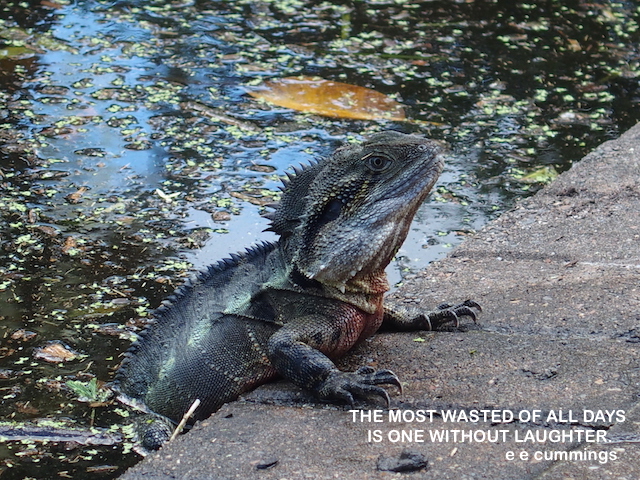I amuse you? Judging laughter is no joke for the brain
Tamara Watson, University of Western Sydney
There’s nothing quite like overhearing a hearty belly-laugh, unless perhaps it’s having a good chortle yourself. The happy likelihood is that, in any case, one guffaw will lead to the other. Laughter is undeniably contagious.
A study published in the journal PLoS ONE today looks into the many types of laughter peppering everyday life and the ways in which they’re interpreted by the “laughter perception network” in our brains.
The researchers, from Germany and the UK, found that brain regions sensitive to processing more complex social information were activated when people heard joyous or taunting laughter, but not when they heard “tickling laughter”.

jamelah
At the acoustic level, tickling laughter was found to be more complex than the other types, and consequently activated brain regions sensitive to this higher degree of acoustic complexity.
In other words, dynamic changes were shown to activate and connect different brain regions depending on the kind of laughter the study’s participants heard.
Figuring out the motivations and emotions behind another’s actions, and the corresponding brain regions involved in this calculation, is central to what’s known as Theory of Mind.
In the context of laughter, when a particular laugh needs to be decoded for more subtle intention, parts of the brain known to do this are recruited for the job. And the very fact a distributed network of brain regions is involved in decoding laughter betrays the range of communicative uses we have for it.
What’s so funny?
The new PLoS ONE study fits into a growing pattern. Recently, scientists have joined centuries of philosophers in pondering the whys and wherefores of laughter. Much consideration has gone into laughter as a social display of positive emotion.

Matt Batchelor
It certainly serves this function in humans – it’s a universal display of positive affect across ages and cultures.
Infants begin to laugh at around two to three months of age, and toddlers, who it is suggested have yet to develop a true sense of humour, laugh raucously while playing.
Laughter also conveys positive emotion in other animals: a range of non-human primates including chimpanzees, bonobos and macaques laugh during social play.

Mark Dumont
Even rats at play surprised the world when it was found that they produce high-pitched chirps, outside the range of human hearing, that reflect a positive emotional state and enhance bonding.
There is more to laughter than just positive emotions. Observations of chimpanzees have revealed occasions where laughter serves to diffuse a tense situation, a scenario we can all relate to.
In this context, it’s been seen as an attempt to modulate the feelings of the listener, manipulating their behaviour for a more positive outcome. Certainly, the contagious nature of laughter would lend weight to the idea that the listener cannot help but have their mood lifted, even in a tense situation.
Laughter clearly plays a very important role in creating and maintaining positive social interaction and cohesion and it may do this by modulating the emotions of both the laugher and the “laughee”.
The dark side of laughing
Humans use forms of laughter not yet found in other animals – laughter that conveys negative meaning such as derision, and this is where things get complicated.
Humans use laughter as a nuanced communication tool. Although it has not yet been extensively studied, the meaning of other types of laughter, unrelated to enjoyment, may be culturally specific in much the same way all but around seven basic facial expressions of emotion are.
Studies implicating a complex network of brain regions involved in decoding laughter are in keeping with the broad range of social purposes for which humans use it.
Indeed, the areas of the brain found to be involved in decoding laughter all subserve functions that align with our understanding of laughter’s purpose, as far as we’ve obtained so far through studies of behaviour.
In line with laughter’s use as a flexible vocal communication tool, studies have shown a role for regions of the cortex known to be involved in processing speech. This concurs with laughter being a complex, meaningful vocalisation with many similarities to speech in terms of how we create the sound and what it sounds like.
Reflecting the diverse messages and effects of laughter on the listener, there are a range of other brain areas involved including
- the amygdala, a subcortical structure involved in the regulation of emotions in humans and other animals
- visual association areas, which have strong connections to auditory cortex and are involved in audiovisual speech processing, really point to the contribution of laughter in face-to-face communication, and suggest that hearing it is supported by also picturing the facial expression it accompanies
- the pre-motor cortex, which may be crucial in creating laughter contagion
On hearing someone laugh, if we are moved in the direction of laughing ourselves, via automatic activation of motor areas of the brain, this would further suggest laughter can directly manipulate social interactions in a positive direction.
Laughter’s links to Theory of Mind
The PLoS ONE study, by examining laughs with recognisably different meanings, including joy and taunting, also shows the involvement of areas of the brain important to Theory of Mind.

apdk
When the laugh needs to be decoded for more subtle intention, parts of the brain known to do this are recruited for the job.
That a very distributed network of brain regions is involved in decoding laughter betrays the range of communicative uses we have for it.
The take-home message from psychology and neuroscience studies is that laughter is an undeniably ancient form of communication that we share with a surprising range of other animals.
Fundamentally, we laugh to get along with others and make life more pleasant.
Yet behind this basic function, the human brain has turned a powerful communication tool into a language of its own with all the associated complexity of decoding that comes with it.
![]()
Tamara Watson is ARC Post Doctoral Research Fellow in Visual Neuroscience at University of Western Sydney.
This article was originally published on The Conversation.
Read the original article.


Recent Comments